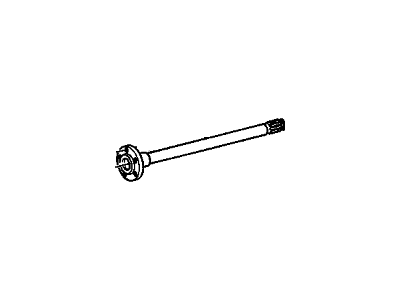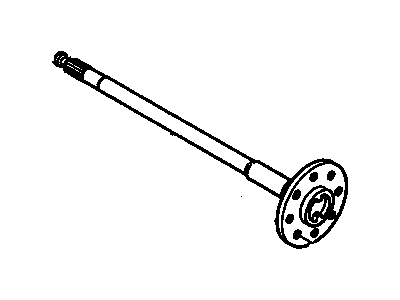My Garage
My Account
Cart
Genuine Chevrolet C1500 Axle Shaft
Car Axle Shaft- Select Vehicle by Model
- Select Vehicle by VIN
Select Vehicle by Model
orMake
Model
Year
Select Vehicle by VIN
For the most accurate results, select vehicle by your VIN (Vehicle Identification Number).
9 Axle Shafts found
Chevrolet C1500 Rear Axle Drive Shaft
Part Number: 26010416$240.70 MSRP: $380.44You Save: $139.74 (37%)Ships in 1-3 Business Days
Chevrolet C1500 Axle Shaft
Chevrolet C1500 autos' Axle Shaft is always a vital element needed for the transmission of power from the differential to the drive wheels that can independently rotate for better grip. Depending on the type of the car or a truck, there are solid axles for earlier models and the half axles for cars which have independent suspension systems. The differential and axle shafts are housed in the solid axles whereas half shafts relaying the power from the transaxle to the wheels. Axle shafts can rub against the nearby objects and get damaged resulting in problems such as noise and vibration while halfshafts may develop problems due to damage to the CV Joints or the boots on the halfshafts. Altogether, Axle Shafts provide assistance in case of weight-bearing along with the supply of torque and keeping the direction of the wheel aligned in Chevrolet C1500 vehicles.
Each OEM Chevrolet C1500 Axle Shaft we offer is competitively priced and comes with the assurance of the manufacturer's warranty for the part. Furthermore, we guarantee the speedy delivery of your orders right to your doorstep. Our hassle-free return policy is also in place for your peace of mind.
Chevrolet C1500 Axle Shaft Parts Questions & Experts Answers
- Q: What are the two types of rear axle shafts used on Chevrolet C1500?A: Two types of rear axle shafts are used in the drive axles, Semi-floating and full-floating. Semi-floating axleshafts are supported at the outer ends of the axle tubes by roller bearings pressed into the outer end of the axle tube, and retained in the differential splines. Full-floating axleshafts ride in differential splines at their inner ends, and are bolted to the wheel hub at the outer end. 4WD models use a completely independent front axle assembly. It consists of a differential and a pair of drive axles. Each drive axle has an inner and outer constant velocity (CV) joint. Just like the transfer case, this offset differential is located to the left and thus there is more distance between it and right front wheel compared to left side wheel's one. This makes up for using two equal-length drive axles on both sides by employing extension axle shaft on its right side.
- Q: How to remove and install a rear axle assembly on Chevrolet C1500?A: Loosen the rear wheel lug nuts, raise the rear of the vehicle and support it securely on jackstands. Block the front wheels to keep the vehicle from rolling off the stands. Remove the rear wheels. Position a jack under the rear axle differential case. Disconnect the driveshaft from the rear axle companion flange. Fasten the driveshaft out of the way with a piece of wire from the underbody. Disconnect the shock absorbers at the lower mounts, then compress them to get them out of the way. If equipped, disconnect the vent hose from the fitting on the axle housing and fasten it out of the way. Disconnect the brake hose from the junction block on the axle housing, then plug the hose to prevent fluid leakage. Remove the brake drums. Disconnect the parking brake cables from the actuating levers and the backing plate. Disconnect the spring U-bolts. Remove the spacers and clamp plates. Lower the jack under the differential, then remove the rear axle assembly from under the vehicle. Installation is the reverse of removal. Lower the vehicle weight onto the wheels before tightening the U-bolt nuts completely. Bleed the brakes.
- Q: How to remove and install the Full-floating axle shaft on Chevrolet C1500?A: Remove the bolts which attach the axleshaft flange to the hub. There is no need to remove the wheel or jack up the vehicle. Tap the flange with a soft-face hammer to loosen the shaft, then grip the rib in the face of the flange with a pair of locking pliers. Twist the shaft slightly in both directions and withdraw it from the housing. Place a drip pan under the outer end of the axle to catch any lubricant which might leak out while the axle is removed. Installation is the reverse of removal. Be sure to hold the axle shaft level to engage the splines at the inner end with those in the differential side gear. Always use a new gasket on the flange and keep both the flange and hub mating surface free of grease and oil.
- Q: How to remove and install a front drive axle on Chevrolet C1500?A: Remove the hubcap on the side the axle is being removed from. Loosen the wheel lug nuts. Loosen the hub nut 1/4-turn, then raise the vehicle and support it securely on jack-stands. Remove the wheel. Remove the skid plate (if equipped). Remove the stabilizer bar and separate the tie-rod end from the steering knuckle. Remove the hub nut and washer. Remove the axle shaft flange bolts. Support the lower control arm with a floor jack. Separate the upper control arm from the steering knuckle. If necessary, detach the brake hose bracket and speed sensor wiring harness from the upper arm. Use a puller to push the outer axle end out of the hub assembly, then remove the axle assembly. Caution: Once the axle shaft or hub nut is removed, DO NOT allow the vehicle's weight to load the front wheels. This could cause the front wheel bearing inner races to separate, resulting in damage to the front brake and suspension components or personal injury. Installation is the reverse of removal. Be sure to tighten the hub nut and the flange bolts to the torque. Tighten the upper ball joint-to-steering knuckle nut to the torque.
- Q: How to remove and install rear axle shafts on Chevrolet C1500?A: Raise the rear of the vehicle, support it securely on jackstands and block the front wheels. Remove the wheel and brake drum. On locking differential equipped models, remove both rear wheels and brake drums. Remove the differential cover and allow the lubricant to drain into a container. Remove the lock screw and pull out the pinion shaft. Have an assistant push in on the outer flanged end of the axle shaft while you remove the C-rock from the groove in the inner end of the shaft. Rotate the differential for access, support the pinion shaft so it won't fall into the case, then remove the lock screw. Withdraw the pinion shaft part way. Rotate the differential until the shaft touches the case, providing enough clearance for access to the C-locks. Use a screwdriver to rotate the C-lock until the open end points in. With the C-lock in position so it will pass through the end of the thrust block, push the axle shaft in and remove the C-lock. Repeat the operation for the opposite axle shaft. With the C-lock removed, withdraw the axle shaft, taking care not to damage the oil seal. Some models have a thrust washer in the differential; make sure it doesn't fall out when the axle shaft is removed. To install, carefully insert the axle shaft into the housing and seat it securely in the differential. Install the C-lock in the axle shaft groove and pull out on the flange to lock it. Insert the pinion shaft, align the hole in the shaft with the lock screw hole and install the lock screw. Tighten the lock screw to the torque. Install the C-locks with the pinion shaft still partially withdrawn. Make sure the C-locks are positioned correctly. Withdraw the axle shaft carefully until the C-lock clears the thrust block. After the C-locks are installed, push the pinion shaft into place with the groove lined up with the lock screw hole, then install the lock screw. Tighten the lock screw to the torque. Install the cover and fill the differential with the lubricant. Install the brake drums and wheels and lower the vehicle.
















